The Revenue Leader's Guide to AI Transformation
Published:

A new era of sales has arrived
Structural economic change has tightened the buying climate. Nearly 90% of executives believe we’re entering a prolonged period of volatility. Uncertainty and tighter budgets make for slower buyers. That’s why 55% of B2B buyers say their purchase cycle times have gotten longer. In response, more than half of companies have downgraded their growth expectations.
At the same time, modern buyers are more autonomous and self-directed than ever. Sellers, who used to have 100 yards of playing field, suddenly face just 20 yards of open space. Instead of weeks and months to show value and earn their buyer’s trust, they just have days.
A lot of sellers can’t deliver in this new era. Less than 50% of sales leaders think their reps have the skills to succeed in the new sales landscape.
For so long, enterprises relied on sprawling sales tech stacks that did little to help sellers and less to aid buyers. The industry’s go-to strategy was more. More emails, dials, and messages. More noise. More confusion.
It barely worked then. It definitely doesn’t work now.
Thankfully, things are changing. We’re hurtling towards a data-informed, AI-enhanced future. AI has awakened hope for go-to-market executives grappling with The Great Growth Squeeze.
This isn’t just an evolution in sales technology. It’s a revolution driven by AI.
AI offers new possibilities and capabilities. It’s giving revenue teams a way to fight back against a tougher selling climate — so much so that AI is now a mandate for go-to-market leaders.
But throwing AI technology at the problem doesn’t guarantee efficient growth. You need firm foundations if your AI transformation is to succeed.
Here’s how we’re coaching our customers to deliver a robust AI strategy.
Getting started with AI
Most digital transformation programs fail, petering out long before they have delivered a positive return. AI transformations, which grapple with new technology and novel processes, face even greater challenges.
Here are some of the most common reasons AI transformations descend into chaos:
- Confusion: Leaders, business units, and employees can’t rally behind change if they don’t know what it’s supposed to do.
- Misalignment: If teams chase different objectives, the whole program is destined to deliver a misaligned outcome.
- Risk management: Security, governance, and trust concerns are all valid. If left unaddressed, they’ll rightfully block implementation.
Effective change managers acknowledge the risks and mitigate them upfront. They set a shared vision and lay solid foundations. But individual leaders can only do so much. For organization-wide AI transformation, they need support. They need an AI council.
1. Build an AI council
An AI council acts as your strategic voice on AI. It directs innovation, aligns teams, and keeps everyone on the right side of regulations.
The best councils include cross-functional representatives from your enterprise. When recruiting your colleagues for your council, here are a few roles to start with:
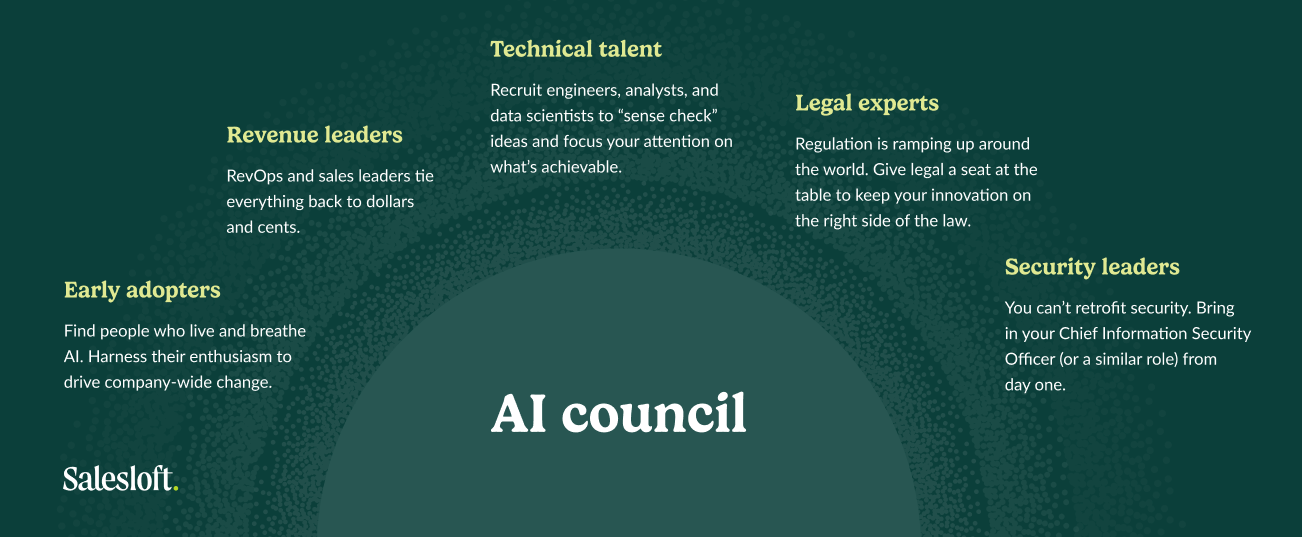
A group of talented individuals is impressive, but a cohesive team is all the more effective. To cultivate buy-in and drive home accountability for specific roles, we recommend drafting a project charter (also called “terms of reference”) for your council. Spell out what you want them to do and how your enterprise should engage with them.
This should include things like setting innovation guardrails, whether teams require council signoff for novel use cases, and how to address thorny issues like ethical concerns.
2. Set your mission
AI as a buzzword doesn’t drive growth. Giving every team a generic generative AI tool often does more harm than good. Successful transformations demand purpose.
Work out why you’re using AI. Do you want to claw back the time reps spend on low-value admin work? Do you want to maximize your cross-sell, upsell, and renewal opportunities? Do you want to identify and emulate the patterns of your best performers? Do you want to pull back the curtain and see when prospects are coming on the market?
Before implementing AI, ask yourself:
- What can you automate?
- What is uniquely human?
- How can that human value be augmented?
As you’re exploring purpose, use your AI council as a check to keep your mission realistic, within your IT and governance standards, and effective.
Tying transformation to a crystal clear mission gives you a goal, something behind which everyone can rally. Once you have that in place, you can begin thinking about implementation.
3. Identify use cases
AI is a transformative technology. It can save sellers from routine administrative work, supercharge sales organizations, and deliver efficient growth. But you already know that change has to be thoughtful and it doesn’t happen overnight — otherwise you wouldn’t be reading this guide.
AI without a use case that drives some kind of business outcome is totally pointless.
Start by brainstorming how your organization could deploy AI in clear use cases to achieve your objectives.
Here are a few examples to get you started:
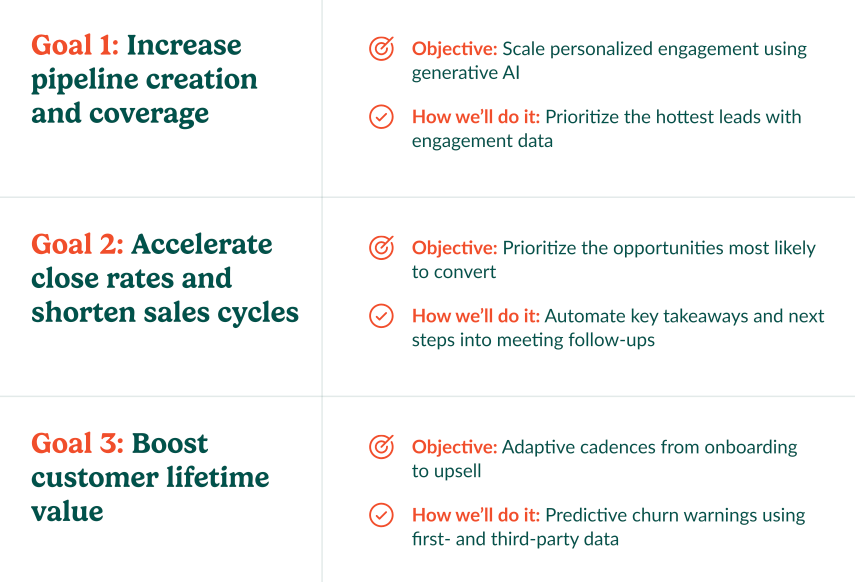
Don’t be tempted to develop and launch every idea in one big bang. Sustainable transformation is iterative and gradual. So start with small experiments and build on your successes.
Learn from other enterprise transformations
Avoiding common pitfalls
Transformation programs are difficult, especially during the Great Growth Squeeze. Revenue leaders simply don’t have time to inch their way to success via trial and error. They need results — now.
Great leaders shortcut the learning process. They watch others, emulate their successes, and avoid their mistakes.
Here are the key things they look out for.
Does it protect human activities?
Automating everything isn’t sensible. You need to sort your organization’s automation opportunities from the fundamentally human work.
Sales is a human endeavor. There’s a lot that human sellers should do.
AI raises the bar for all the human skills it can’t automate — emotional intelligence, vision-setting, complex and dynamic problem-solving across matrixed organizations. Sales reps need to focus on those skills.
Buyers want a person they can trust, not an anonymous piece of software. If your sales motion requires relationship-building, trust, and guidance, those are complex areas that demand humans.
Equally, there’s a lot that humans shouldn’t do.
Having someone manually check 10 inboxes is a bad use of their time. Making them read through lots of historic data to work out deal context isn’t much better.
Repetitive, mundane, and boring tasks that consume hours of reps’ time are ripe for automation. Automate the tedious, dull, and straightforward jobs, while protecting high-value human tasks.
Top activities companies are asking AI to do instead of sales reps:
- Researching buyers
- Drafting prospecting emails
- Scheduling calls or appointments
- A/B testing emails and scripts
- Summarizing deal histories
- Prioritizing which accounts to focus on
- Identifying next best action to advance deals
Set your AI guardrails
Unfettered AI experimentation is risky. Empower individuals and teams to experiment safely by setting AI guardrails.
Here are some basic guardrail ideas.
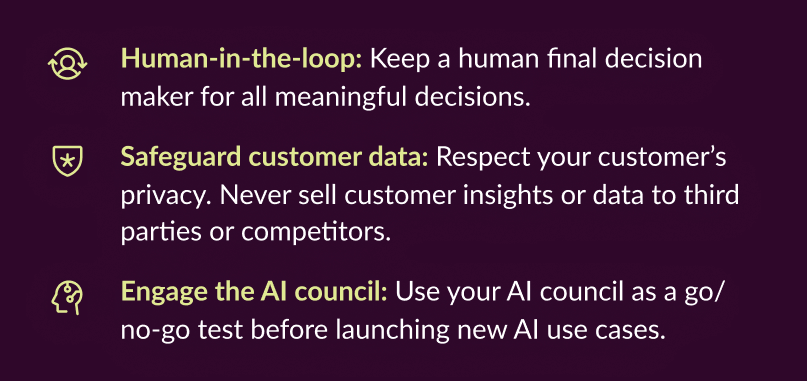
The goal of guardrails isn’t to stymie innovation. It’s to unleash people’s creativity safely and securely. Once people know what they’re allowed to do, they’ll seize the opportunity.
Use AI as a starting point
Today’s AI tools are like de facto teammates — assisting, helping, and augmenting. They work best in collaboration with people, not as lone agents operating autonomously.
Leading revenue teams use AI as a starting point and trust humans to add context, nuance, and special sauce extras like storytelling, personality, and empathy.
For example, reps can use generative AI to spin up a first follow-up email in seconds. Instead of spending excess time staring at a blank Word doc, they can spend a couple of minutes reviewing for factual accuracy, finessing the language, and adding personalization.
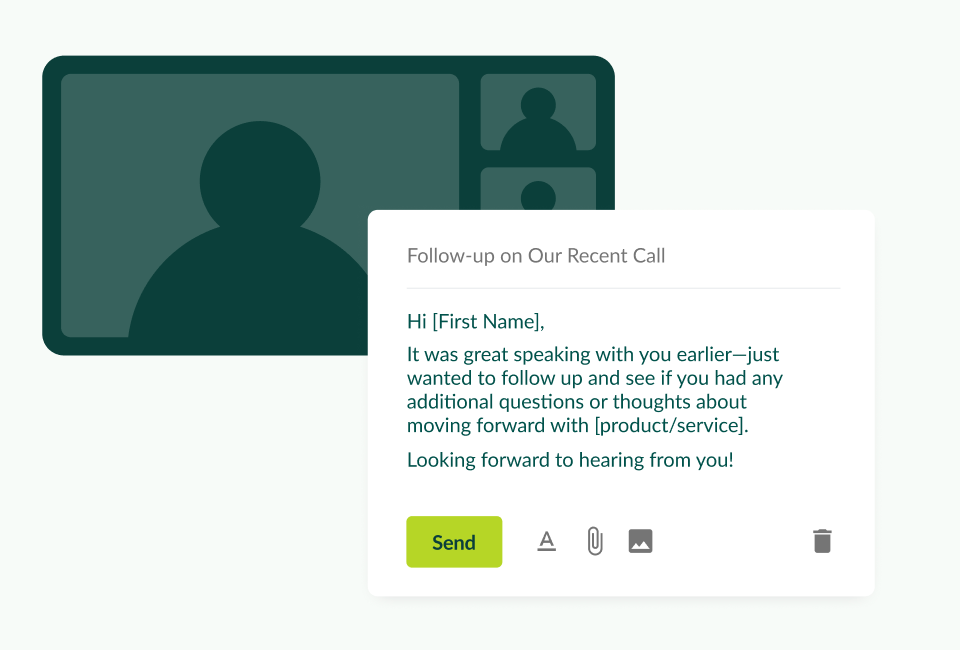
Build or buy: Explainable AI
Some AI tools operate like a black box. Their processes are opaque. Their decisions are hidden. You feed in data, something happens, and the tool gives you an output.
That’s risky because you don’t know why the tool made its decision. Was the logic robust? Is the decision-making criteria fair? Was the result a fluke? You don’t know.
Conversely, explainable systems reveal how the AI came to a conclusion.
We ground all AI in clear use cases. We make it explainable and join it to broader workflows.
Great revenue platforms draw a line between insight, action, and outcome, explaining how each one impacts the other.
Explainable tools inspire trust in products and use cases, since people can understand what’s going on. And trusted solutions are much easier to implement and scale across an organization.

Protecting your data and insights
Safe, secure, and trusted
As AI shifted from niche technology to go-to-market keystone, leaders got a better view of its benefits and risks. Data breaches, adversarial attacks, data manipulation, the list goes on. As companies raced ahead with AI transformation, many of these risks played out in embarrassing newspaper headlines. The silver lining of bad news stories is that security became top of mind for everyone.
Today, security is table stakes for AI transformation.
That is a huge advantage because you can’t retrofit security. Secure transformation needs a strong data strategy and robust data security from data one to protect your assets.
Here is how we recommend you build a strong data foundation to keep your information secure.
Don’t neglect your data strategy
Without quality data, AI simply doesn’t work. Great AI strategies need equally good data strategies.
To put your data strategy under the microscope, ask yourself these three questions:
- How are your systems using data in their AI? “ChatGPT on everything” doesn’t get you far. Drill down into how your data is relevant to your AI use cases.
- How are your systems working together? Siloed data slams the brakes on transformation. What matters about data is whether you use it when you need it.
- How can you leverage internal data and AI? Internal data is gold dust, but it requires a truly open system to bring it into your AI systems.
Your data strategy won’t be perfect — it never is. But understanding what you need to drive an AI transformation is the first step to change.
Once you’ve set your strategy, work out what data and data flows you need in place to deploy key use cases.
Protect and safeguard data
Data ownership matters, especially when it’s your prospect’s or customer’s information.
Reputable third-party vendors will respect your data privacy and ownership.
For example, when you work with Salesloft and our AI, your data remains yours and always will. We don’t sell your insights to competitors. We use private AI models to keep all our data in-house and thoroughly vet any sub-processors using rigorous enterprise-grade security standards.
Our data model is trained on sales data and business outcomes. It looks very different from an off-the-shelf GPT or Llama product.
No matter the vendor you select, ask tough questions and get clear answers before implementing a service.
Must-ask questions for AI sales tech procurement:
- How does the vendor ensure security and compliance?
- Can customers turn off every generative AI capability?
- Does the vendor take a governed approach (features are first released as a restrictive capability) to launches?
- How does the vendor train its AI models?
- What processes are in place to surface and address biases and unintended consequences?
- Does the vendor have an internal AI policy governing their use of AI tools?
Connecting AI to real business goals
Build for impact. Sell the story.
New technology, no matter how shiny, means nothing to your C-suite if it doesn't have an impact on business goals.
Executives need to see the impact on real business goals. When they can see that, they’ll rally behind an idea and unlock resources.
Wherever possible, evaluate your AI transformation against tangible business objectives.
You need the right technology to draw those throughlines. Some tools will give you insights. Others share best actions or outcomes. And a few will stitch it all together, allowing you to see the full thread from insight to action to outcome.
- Employee productivity: Reps spend most of their time on low-value admin work. (Find out how much it’s costing you here.) Show how AI frees up your reps’ time to focus on the highest-value activities.
- Lower costs: Do more with less and drive bottom-line savings. Explain how your work saves time, boosts productivity, consolidates technology, simplifies processes, and shores up data accuracy. And prove how those wins save your organization real dollars and cents.
- Drive growth: Demonstrate how AI makes predictive decisions about your business and aligns your GTM resources to the white space opportunities.
A rock-solid AI strategy that delivers results
AI is advancing so fast that it’s no longer a question of if organizations invest in AI, but when. This shift has led to a clear division between companies that have moved fast and those lagging behind.
To secure your place among the leaders, you need to move swiftly and confidently. Set the foundations and then deliver the goods. We recommend approaching your transformation through the lens of three different questions:
- What accounts should you focus on, and why?
- What should you say to these accounts?
- How can these conversations help you hit your revenue goals?
These questions will keep you focused on what matters — pipeline, customers, and revenue — and ward off vanity projects that don’t move the needle. They’ll serve as the foundation for a new rock-solid go-to-market strategy that delivers results now and well into the future.
Your 10-Step AI checklist
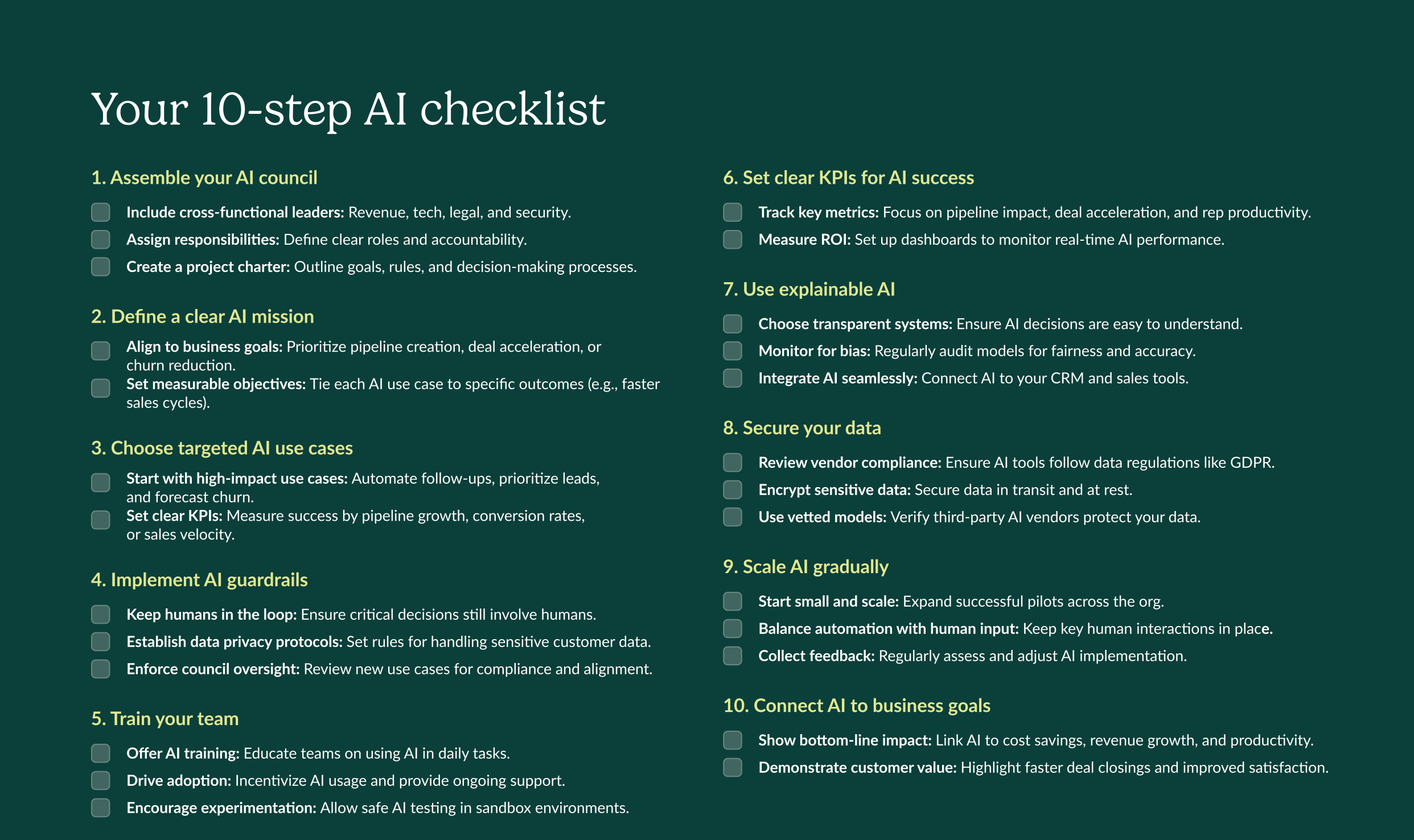
Durable revenue growth — now and forever
We are standing on the shoulders of giants — thousands of the most efficient, effective, and inspiring brands around the world. From working with them, we know what it takes to help customers drive durable revenue growth. It won’t come from listening to conversations, AI-powered forecasting, or focusing on intent data alone. The future of go-to-market lies in a unified solution, one that draws together the most advanced capabilities to deliver a durable revenue engagement model.
Salesloft delivers a Performance Force Multiplier, enabling the most demanding companies to drive durable growth in a new economic era. Salesloft’s Revenue Orchestration Platform, delivering the first AI-powered Durable Revenue Engagement Model, keeps market-facing teams on top of all buyer signals, with outcomes-driven prioritization so they always act first on what matters most.





























